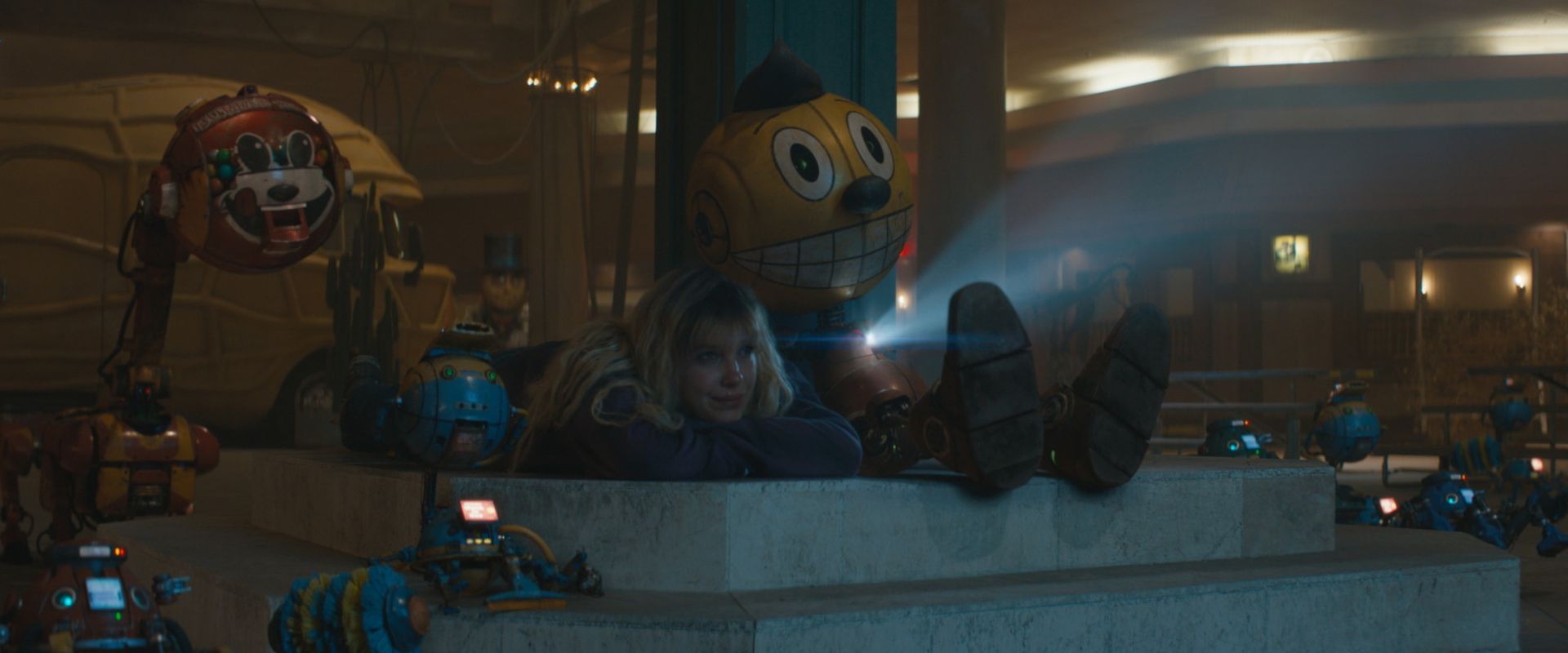Digital Domain Boldy Tackles Visual Effects for the Russo Brothers’ “The Electric State,” Bringing Cosmo and Key Characters to Life
04.01.25Inspired by the 2018 graphic novel by Swedish artist Simon Stålenhag, Netflix, in collaboration with the Russo Brothers, brings this visually stunning story to life. The film, which is set after a robot uprising in the 1990s, follows the protagonist, an orphan named Michelle (played by Millie Bobby Brown), who embarks on a journey across the country to find her long-lost brother. Digital Domain artists, led by Visual Effects (VFX) Supervisor Joel Behrens, were tasked with bringing her journey and the key robot characters to life.
As the lead VFX vendor contributing to over 850 shots on the film, Joel and Digital Domain collaborated closely with Production VFX Supervisor Matthew Butler, the Russo Brothers and Oscar-winning Production Designer Dennis Gassner, ensuring that character designs resonated with the film’s retro-futuristic themes. While Digital Domain’s primary focus was on crafting and developing the film's main characters, such as Cosmo, Herman, Mr. Peanut, and Colonel Marshall Bradbury (“The Marshall,” played by Giancarlo Esposito), the award-winning artists were responsible for 61 character builds and developed nearly 480 assets, including everything from detailed characters to essential environmental elements like rocks, grass and terrain. This extensive contribution highlights Digital Domain's crucial role in shaping the film's visual narrative and bringing its unique characters to life.
Bringing the Characters to the Big Screen
To animate and bring the film's robot characters to life, Digital Domain prioritized creating realistic movements and interactions, which were essential to making them feel authentic. To accomplish this, the Digital Domain team carried out extensive motion studies and studied real robots from Boston Dynamics and the latest advancements in modern robotics to ensure that the robots’ joints and overall structures were both logical and physically plausible.
The talented Digital Domain look development and texture teams were crucial in ensuring that all the robots functioned realistically and looked visually impressive. Each hero character needed to withstand scrutiny in close-up shots, requiring meticulous attention to detail in their design and animation. This emphasis ensured that the characters looked impressive, and every subtle movement and expression conveyed the characters' emotions, enhancing their realism and connection with the audience.
Digital Domain artists also considered scale, design, and the desired look, taking illustrations and creating rough mock-ups while adding additional detail. For example, Digital Domain artists designed Herman’s face to incorporate the CRT elements of the screen, determining how he would move and emote with that retro design. The artists also considered the performances of the on set motion actors who were captured on set in real time using Xsens motion capture suits and witness cameras, which greatly informed the animation process.
The Introduction of Cosmo
Cosmo, directly inspired by the book, required careful attention to physical action since he does not speak and communicates solely through pre-recorded voice recordings from the “Kid Cosmo” cartoon. Much of the emoting and information he conveys relies on physical acting, presenting a fun challenge for the animation team. Animation Supervisor, Liz Bernard, led the team responsible for crafting intricate and nuanced performances for a variety of robots, including the captivating character, Cosmo. "Our overall directive was to focus on the subtleties of performance," Bernard explains. "For characters like Cosmo, we relied on pantomime and body language to convey his personality and intentions. Head tilts, changes in eye direction, posture changes, and hand posing were key to building his emotional presence on the screen." To enhance this expressiveness, Digital Domain artists added lights to his eyes that flicker, dim, and brighten to reflect his emotional cues. While subtle, these effects significantly enhanced Cosmo’s performance.
Herman, The Marshall, Mr. Peanut, and Other Robots
Herman, the Marshall, and Mr. Peanut were not in the book, and were created specifically for the film, necessitating several rounds of detailed design work for Digital Domain. Digital Domain created Herman in both a 4-foot primary form and a 20-foot version, complete with a distinct color palette. His robust legs were specifically engineered by the Digital Domain team to minimize the need for pistons, enhancing his functionality. The design of his face posed another challenge as it features a CRT screen reminiscent of computer technology from the early 90s. The team conducted extensive research on the look and feel of these monochrome CRT monitors, and developed a style of successive staccato facial expression changes which would crossfade from one to another, via a custom set of quadratic decays per pixel. This unique approach to expression changes added depth, period specific realism, and opportunities for comedy to Herman’s character.
The Marshall, one of the film’s more narratively complicated characters, is a drone robot, meaning that he does not have a mind of his own but is, instead, directly operated by a human. Digital Domain developed the drone robots, whose large, elongated heads were based on the shape of the Sentre neurocaster VR helmets seen in the book. Each drone’s head also showed a video feed of the drone operator in real time, which helped distinguish between the drones and the more sympathetic robots who have their own consciousness. The Digital Domain animators also gave the drones a more clunky, heavier walking style as they were meant to feel more cold and inhuman than the ‘bots.
Creating Mr. Peanut was complex because the team needed to design an animatronic robot that could speak without appearing uncanny, yet still look photoreal. They began with a standard set of about 80 facial shapes typically used for animating human characters, but, in time, discovered that restricting the shapes to about a dozen gave a much more charmingly animatronic style to his facial performance. As one of the oldest characters in the film, they crafted him to embody the essence of his long history, making him appear as though he had been around for 40 to 50 years. Subtle cracking in his skin layer, subtle texture variations, and the character’s slight limp and use of a cane all helped to explain his past through his physical appearance and performance.
Digital Domain was also responsible for Pop Fly, Perplexo, and several other robots seen throughout the film. The animation team pushed boundaries to find a unique personality and physicality per character, based on the robot’s design and the voice actor’s performance. The Rigging and Pipeline teams developed a “propeller tool” to ensure that the flight mechanics of the airborne Sentre drones and the Marshall were correct and as true to real world helicopter physics as possible.
“As far as character pipeline and animation are concerned, this project marked a monumental leap forward for our entire team in terms of managing both the volume and complexity of characters,” said Joel. “The scale of this undertaking pushed us to innovate and collaborate like never before. I am incredibly proud of every individual who contributed their talent and dedication to bring this ambitious vision to life.”
The Haunted Amusement Park
In the "Haunted" Amusement Park scene, the group arrives at Happyland and encounters several scavenger robots. The sequence features impressive crowd work by the Digital Domain team, highlighted by a thrilling chase through the amusement park, where the Sentre drones and Marshall pursue Cosmo. Later in the scene, the Marshall and Mr. Peanut engage in a fierce battle within the mad scientist lab. The Digital Domain team meticulously recreated the lab in CG by scanning and digitally rebuilding the set, which enabled them to choreograph the fight with precision during post-production.. The team executed extensive FX work, including the use of Tesla coils, sparks, robot damage, and interactive lightning arcs that added to the dramatic atmosphere.
The Mall Sequence
The Mall Sequence, shot on location, posed significant challenges, as it required the inclusion of hundreds of robots. For this sequence, Digital Domain had to incorporate and animate hundreds of robots, utilizing crowd simulations alongside hero animated robots. While Digital Domain created many of the robots using their Maya pipeline, others were developed by different vendors, requiring Digital Domain to ingest and integrate those assets to populate the scenes. These crowds were unconventional as they were composed of various robot styles, each with unique proportions. For example, some robots moved on tracks instead of wheels, some were bipeds, and others had three legs. This diversity required the animation team to animate each individual character. Each animator was responsible for their own group of robots, infusing each character with its distinct style and personality.
Digital Domain was also responsible for The Mine Sequence, The Walk Across the Exclusion Zone desert, and much more. In addition to these key sequences, Digital Domain also contributed to several environments including Fort Hull, the exterior of the mine, exclusion zone, the robot sanctuary mall, and the Happyland amusement park.
Collaborating closely with Matthew Butler and the Russo Brothers, Digital Domain’s visualization team also played a crucial role in the film by providing technical visualization (techvis) and previsualization (previs) to fine-tune elements such as timing, speed, and tempo. Led by Visualization Supervisor, Jason Donnelly, the vis team transformed scripted moments into dynamic sequences, effectively bringing the filmmakers' vision to life. The team also made significant contributions to character design, concept, and look development, helping to shape the characters' designs and functions. Key sequences included the Mine Sequence, the End Battle Sequence, and others.
The Electric State is now playing on Netflix.


